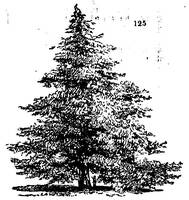416. The Pinus Cembra, Cembran Pine, Aphernousli Pine, Siberian Stone Pine, or Siberian Cedar (fig 125.), is one of the most useful trees in Switzerland. It is, indeed, of very slow growth; one of these trees, cut down when nineteen inches in diameter, displayed 353 concentric circles. Its usual growth is a span in height in six years. The timber of the Cembran Pine has a most agreeable perfume, and is much used for domestic utensils, as well as for wainscoting rooms. A traveller, who visited the chateau of Tarasp, was struck, in almost every apartment, with the perfume of this wood; and he remarks it as a surprising and inexplicable circumstance, that the wood should have exhaled this perfume for some centuries in undiminished strength, and without the wood itself having suffered any decrease of weight. But this wood possesses another recommendation: rooms wainscoted with it are not infested with bugs or moths. Its seeds are esteemed a delicacy: they are eaten in great quantities at the winter parties; and on those occasions, it is said, the fair sex display, in extracting them, a degree of skill, mixed with much innocent gaiety and vivacity. This species of pine is becoming very rare in the Alps. In order to expedite and secure its growth, and thus remove the principal objection to its cultivation, the seeds should be deposited in a compost of earth, and of the clippings and leaves of the pinaster and the larch; or this compost should be put round the roots of the young plants. The larch is another valuable tree, not only for the purpose of forming manure, but also for its durable timber. This lasts four times longer than pine timber grown at the same elevation. If, therefore, the larch were planted where the Scotch pine now grows, it is evident that much forest ground might be gained and applied to pasture. The foliage of these and other trees is carefully collected on the mountains for winter fodder, put into large nets, and then hurled down into the valleys. (For. Quart. Rev., Jan. 1828.)

